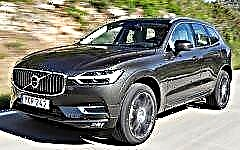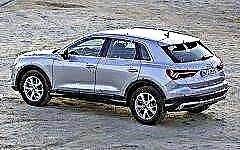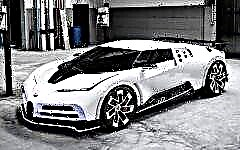 Review of Toyota Prius 2017: appearance of the model, interior, specifications, security systems, prices and equipment. At the end of the article - test drive the 2017 Toyota Prius!
Review of Toyota Prius 2017: appearance of the model, interior, specifications, security systems, prices and equipment. At the end of the article - test drive the 2017 Toyota Prius!

Contents of the review:
- Appearance
- Salon
- Features Toyota Prius 2017
- Security systems
- The cost and configuration of Toyota Prius 2017
Perhaps, there is not a single car enthusiast in the world who is not familiar with the Toyota Prius hybrid hatchback, whose history dates back to the second half of the 90s of the last century. Despite its discreet appearance, the first or third generation of the model has sold more than 3.5 million copies around the world, and the owners of the hybrid include world famous athletes, movie stars and politicians.
In September 2015, Toyota management held a special event, during which the fourth generation of the hybrid Prius was first demonstrated, and the novelty celebrated its official debut a few days later, at the Frankfurt Motor Show. The car instantly attracted great interest from the world community, in which it was helped not only by its futuristic appearance, but also by a noticeably improved technical component.
The first sales of the model started in Japan back in 2015, but the car appeared on the European market only by the end of 2016. However, the most important and pleasant news was the fact that at the beginning of 2017 the novelty reached the Russian market.
2017 Toyota Prius exterior review

It should be noted right away that Toyota Prius never tried to become the standard of beauty, since the exterior was always based on the concept of maximum practicality and economy. Nevertheless, each new generation of the hatchback became more and more attractive, and the fourth Prius was no exception. Of course, the car is still not the crown of style, but the design of the novelty has become as futuristic as possible and in some way avant-garde - the car instantly attracts the eyes of others.

The front part of the car has acquired an original T-shaped head optics, stylish stampings on the hood, a neat strip of false radiator grille and a massive front bumper, into which a large air intake and spectacular fog light triangles have been inserted.
The profile of the car is made in the spirit of its predecessors, while the novelty has become slightly lower, which made the silhouette more impetuous. In place remained the proprietary falling roofline, the complex relief of the side edges, replete with aerodynamic stampings, and a heavily littered windshield, designed to maximize the aerodynamics of the model (drag coefficient is 0.24 Cx).

The rear of the hatchback looks no less futuristic than the "muzzle", which is facilitated by the original shape of the trunk and spoiler, as well as spectacular vertical marker lights that extend almost to the base of the rear bumper.
Overall characteristics of the novelty are:
- Length - 4540 mm (an increase of 60 mm);
- Width - 1760 mm (an increase of 15 mm);
- Height - 1479 mm, which is 20 mm less than the previous generation;
- Wheelbase - 2700 mm;
- Ground clearance - 136 mm.
Potential buyers can choose from 7 different body color options, including: white, gray metallic, black metallic, dark blue metallic, silver metallic, red mother-of-pearl and white mother-of-pearl.
Interior Toyota Prius (2017)

The interior design of "Prius" looks no less impressive than its exterior. This is especially true of the central part of the torpedo, vaguely reminiscent of the design of a spaceship. The upper part of the central panel is reserved for the dashboard, and the lower part is for the huge LCD display of the multimedia information complex, which is combined with the original microclimate control unit.
Special attention should be paid to the unusual gear shift joystick located on the small "lip" of the center console. A new three-spoke steering wheel "settled" in front of the driver, with the ability to control the multimedia system and the on-board computer.
The ergonomics of the driver's seat does not raise any questions, which cannot be said about the finishing materials, which look and feel rather modest (read cheap), which does not quite fit with the overall design concept.
The front seats are distinguished by well-felt lateral support and a wide range of adjustments, which allows you to easily accommodate a person of almost any height and build.
The rear sofa is ready to accept three adult riders, but if there is more than enough space in the legs and shoulders, then the height can cause a number of inconveniences, which is due to the sloping roofline.
The volume of the trunk in the front-wheel drive modification is 502 liters, but no one bothers to lower the rear seats and get the maximum 1633 liters of loading space. In the underground luggage compartment there is a "spare wheel" and a small repair kit. The luggage compartment in the all-wheel drive version is 457 liters.
On the Russian market, the car is offered in two interior color options - light and dark, where the first looks richer, and the second is as practical as possible.
Specifications Toyota Prius 2017

The car is set in motion with the help of a single hybrid installation, represented by a 1.8-liter gasoline engine and an electric motor, the declared power of which is 98 and 72 "horses", respectively. The motor works in tandem with a modern stepless variator, which allows the car to develop a maximum 180 km / h, acceleration from 0 to 100 in this case takes 10.6 seconds. In mixed driving mode, a hybrid hatchback consumes about 3 liters of fuel for every 100 km of track, which in theory, given the volume of the fuel tank (43 liters), allows to overcome more than 1000 km.
Unlike its predecessors, the fourth generation Prius is based on the completely new modular TNGA platform, which has increased the torsional rigidity of the body by as much as 60%, and also reduced the total weight of the car by 50 kg.
The suspension of the hybrid is fully independent and is represented by MacPherson struts on the front axle and a multi-link system on the rear. To reduce the total weight of the car, the manufacturer widely used modern grades of steel and aluminum, where the hood, tailgate and part of the front bumper are made of the latter.
The hybrid braking system is represented by disc brakes (on the front wheels with ventilation), which are complemented by a modern anti-lock braking system, EBD, BAS, TRC systems and others. The steering is represented by an electric booster.
Safety of the new Prius 2017

The Japanese traditionally paid a lot of attention to the active and passive safety of the car, equipping it with a large list of standard and optional equipment, including:
- Light and rain sensor;
- Central locking, with the possibility of remote control;
- LED optics;
- Era-Glonass system;
- Anti-lock braking system with EBD system;
- BAS emergency brake booster;
- Cruise control;
- System of exchange rate stability and proprietary slip prevention system;
- Tire pressure sensors;
- Rear View Camera;
- Front and side airbags;
- ISOFIX child seat mountings;
- Three-point belts;
- Active front seat head restraints;
- Parking assistant.
At the same time, in the list of equipment (even as an option), there are no tracking systems for "dead" zones, lane markings and the driver's condition, which, given the considerable cost and positioning of the car, looks somewhat strange.Nevertheless, the car provides an adequate level of safety for both front and rear passengers, thanks to which it can successfully play the role of a car for the whole family. This is also confirmed by the EURONCAP crash tests, in which the car was recognized as the safest family car in 2016.
Price and equipment Toyota Prius 2017

The sale of the Toyota Prius 2017 in Russia started in early 2017, while the cost of the 4-generation Toyota Prius starts at 37.05 thousand dollars (2.112 million rubles), which is almost half more than the Toyota Corolla in top-end equipment.
Unfortunately, or fortunately, on the Russian market the car is offered only in one configuration - "Lux", which includes the following set of systems and equipment:
- Light alloy wheels R15;
- Light and rain sensor;
- Central locking, with the possibility of remote control;
- LED optics;
- Era-Glonass system;
- Full power accessories + automatically folding side mirrors;
- Intelligent system of access to the salon Smart Entry;
- Fully LED front and rear optics;
- Anti-lock braking system with EBD system;
- BAS emergency brake booster;
- Cruise control;
- System of exchange rate stability and proprietary slip prevention system;
- Tire pressure sensors;
- Rear View Camera;
- 7-inch display of the multimedia system;
- Head-up display and dashboard featuring two 4.2-inch LCD screens;
- The system of starting the motor from the button;
- 2-zone climate control;
- Premium audio system from JBL with 10 speakers;
- Multifunctional steering wheel;
- Leather interior upholstery.
For a surcharge, the buyer can equip the car with an additional set of parking sensors, chrome edging for foglights, luggage and bike carriers on the roof, removable tow bar, side moldings and hood deflector, as well as special body and wheel protection Toyota Protect.
Conclusion on the new Toyota Prius Prime 2017
The fourth generation Toyota Prius has got a more stylish and futuristic exterior, a wider list of equipment and improved technical units, however, as before, the car remains a niche proposal. The updated "Prius" is primarily designed for inveterate fans of the model, adherents of green technologies and true geeks, which does not prevent it from remaining one of the most popular and best-selling hybrid cars in the world.
Test drive Toyota Prius Prime 2017:
Toyota











